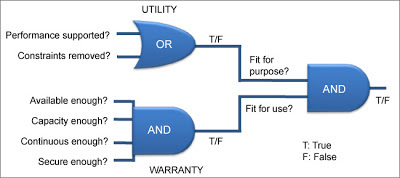I may be a producer, a performer, a director, and a writer (all at different times), but I am also someone else -- I'm a salesman of IT software to businesses. Yes, that's right, when I'm not scheming about how to create fake people and kill them or how to create new rituals in America, I'm telling C-level executives at large New York based companies how they can better improve their processes.
Part of the reason I've stuck at this job and continued to enjoy it is that it gives me some secret all-access pass into large companies and how they work -- from notable media companies, to financial services, to non-profits and higher education organizations. I am, of course, not going to use any names (to protect the innocent), but I figured I might as well share some of the things I learned.
THE ITIL FRAMEWORK: FOCUS ON SERVICE
The area of IT technology I work in has to do with process optimization, which is why I find it so broadly applicable. Really, it has to do with how do groups of people work together to get things done.
ITIL (or the Information Technology Infrastructure Library) is the framework of processes that IT organizations have to deliver service. At the end of the day, it's just a common language to make sure that IT people have an understanding of the different parts of their job.
One of the advantages of ITIL is that the focus of ITIL is on service. All of the IT processes are put together from the perspective of improving service to "customers" -- where customers can be within the company or outside of it.
When you see bad processes, it's probably because they're not service-oriented. Nobody is thinking about the end user. For instance, here's a video that Google Analytics put together showing what some e-commerce websites do wrong:
In this hypothetical online check-out, it's clear that nobody has looked at it from the consumer's perspective -- it's not service oriented.
VALUE CREATION
One of the advantages of ITIL is that the focus of ITIL is on service. All of the IT processes are put together from the perspective of improving service to "customers" -- where customers can be within the company or outside of it.
When you see bad processes, it's probably because they're not service-oriented. Nobody is thinking about the end user. For instance, here's a video that Google Analytics put together showing what some e-commerce websites do wrong:
In this hypothetical online check-out, it's clear that nobody has looked at it from the consumer's perspective -- it's not service oriented.
VALUE CREATION
So ITIL preaches that you need to be service oriented. Another way of putting it is that you need to create value. Their way of looking at value has two levels:
A little handy logical diagram that they use:
- Utility; Is it fit for purpose? (i.e. does it do what it is designed to do?)
- Warranty; Is it fit for use? (i.e. do you have enough of it, is it available enough, etc.)
A little handy logical diagram that they use:
It's a little jargon-y, but they're being specific around it: does it help you do more ("performance supported?") or is it helping you do what you do easier ("constraints removed?"). Those measures of utility and warranty are more technology specific (after all, the arts are not exactly worried if someone hacks into them and distributes them on the internet...), but I think it helps demonstrate what has to come together for a work to create value: the right thing, and access to it.
That's it for tonight. More to follow.


